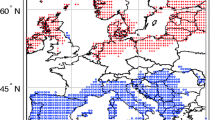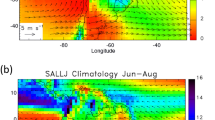Abstract
The objective of this paper is to determine the influence of circulation factors on precipitation in Bulgaria. The study succeeds investigation on the influence of circulation factors on air temperatures in Bulgaria, as the focus here is directed toward precipitation amounts. Circulation factors are represented through two circulation indices, showing west-east or south-north transport of air masses over Bulgaria and four teleconnection indices (patterns)—North Atlantic Oscillation, East Atlantic, East Atlantic/Western Russia, and Scandinavian. Omega values at 700-hPa level show vertical motions in the atmosphere. Annual precipitation trends are mixed and not statistically significant. A significant decrease of precipitation in Bulgaria is observed in November due to the strengthening of the eastward transport of air masses (strengthening of EA teleconnection pattern) and anticyclonal weather (increase of descending motions in the atmosphere). There is also a precipitation decrease in May and June due to the growing influence of the Azores High. An increase of precipitation happens in September. All this leads to a redistribution of annual precipitation course, but annual precipitation amounts remain the same. However, this redistribution has a negative impact on agriculture and winter ski tourism. Zonal circulation has a larger influence on precipitation in Bulgaria compared to meridional. Eastward transport throughout the year leads to lower than the normal precipitation, and vice versa. With regard to the four teleconnection patterns, winter precipitation in Bulgaria is determined mainly by EA/WR teleconnection pattern, spring and autumn by EA teleconnection pattern, and summer by SCAND teleconnection pattern.












Similar content being viewed by others
References
Alexandrov V, Genev M (2003) Climate variability and change impact on water resources in Bulgaria. European Water 1(2):25–30
Alexandrov VA, Hoogenboom G (2000) The impact of climate variability and change on crop yield in Bulgaria. Agric For Meteorol 104:315–327
Alexandrov V, Schneider M, Koleva E, Moisselin JM (2004) Climate variability and change in Bulgaria during the 20th century. Theor Appl Climatol 79(3–4):133–149. doi:10.1007/s00704-004-0073-4
Andreeva T, Martinov M, Momcheva S (2003) Mild winters and the precipitation in the mountain regions in Bulgaria. ICAM/MAP. Available at http://www.map.meteoswiss.ch, access date – 15.05.2014.
Annual Meteorological books. National Institute of Meteorology and Hydrology, Bulgarian Academy of Sciences, Sofia (in Bulgarian).
Grunewald K, Scheithauer J, Monget JM, Brown D (2008) Characterization of contemporary local climate change in the mountains of southwest Bulgaria. Clim Chang 95(3–4):535–549. doi:10.1007/s10584-008-9508-8
Hartmann DL, Klein Tank AMG, Rusticucci M, Alexander LV, Brönnimann S, Charabi Y, Dentener FJ, Dlugokencky EJ, Easterling DR, Kaplan A, Soden BJ, Thorne PW, Wild M, Zhai PM (2013) Observations: atmosphere and surface. In: Stocker TF, Qin D, Plattner G-K, Tignor M, Allen SK, Boschung J, Nauels A, Xia Y, Bex V, Midgley PM (eds) Climate Change 2013: The Physical Science Basis. Contribution of Working Group I to the Fifth Assessment Report of the Intergovernmental Panel on Climate Change. Cambridge University Press, Cambridge, United Kingdom and New York, NY, USA
Kalnay E, Kanamitsu M, Kistler R, Collins W, Deaven D, Gandin L, Iredell M, Saha S, White G, Woollen J, Zhu Y, Leetmaa A, Reynolds R, Chelliah M, Ebisuzaki W, Higgins W, Janowiak J, Mo KC, Ropelewski C, Wang J, Jenne R, Joseph D (1996) The NCEP/NCAR 40-year reanalysis project. Bull Am Meteorol Soc 77:437–470
Koleva E, Alexandrov V (2008) Drought in the Bulgarian low regions during the 20th century. Theor Appl Climatol 92(1–2):113–120
Nikolova N, Boroneant C (2011) Observed changes in precipitation in the Danube river lower basin in the context of climate change. Forum geografic Studii şi cercetări de geografie şi protecţia mediului 10(1):117–128
Nikolova N, Vassilev S (2005) Variability of summer-time precipitation in Danube plain, Bulgaria. Zbornik radova Geografskog instituta “Jovan Cvijić”. SANU 54:19–32
Nojarov P (2006) An assessment of the contemporary tendencies and flood risks on the basis of average monthly precipitation sums in different regions of Bulgaria. In: Proceedings of First national research conference on emergency management and protection of the population. National Security and Defence Research Center, Bulgarian Academy of Sciences, Sofia, pp 157–163 (in Bulgarian)
Nojarov P (2010a) Changes in precipitation regime at peak Moussala for the period 1933–2008. Problems of Geography 3–4:145–165
Nojarov P (2010) Precipitation changes at peak Botev for the period 1947 – 2008. In Proceedings of International Conference “Geography and Regional Development”, Sofia: 243–247 (in Bulgarian).
Nojarov P (2012) Variations in precipitation amounts, atmosphere circulation, and relative humidity in high mountainous parts of Bulgaria for the period 1947–2008. Theor Appl Climatol 107:175–187. doi:10.1007/s00704-011-0473-1
Nojarov P (2013) Circulation over Bulgaria and its connection with NAO indices and Sea Surface Temperatures. Theor Appl Climatol 114(1):329–348. doi:10.1007/s00704-013-0846-8
Petkova N, Koleva E, Alexandrov V (2004) Snow cover variability and change in mountainous regions of Bulgaria, 1931–2000. Meteorol Z 13(1):19–23
Tomingas O (2002) Relationship between atmospheric circulation indices and climate variability in Estonia. Boreal Environ Res 7:463–469
Topliisky D (2005) Chronological fluctuations of climate in Bulgaria during the 20th century. Sofia University, Sofia, Autopaper of dissertation (in Bulgarian)
Tran L, Knight CG, Wesner V (2002) Drought in Bulgaria and atmospheric synoptic conditions over Europe. GeoJournal 57(3):149–157
Velev S (2000) The global changes and the climate of Bulgaria. In: Proceedings of International Scientific Session “50 years Institute of Geography, BAS”, Sofia: 99–106 (in Bulgarian).
Velev S (2006) Global climatic change and Bulgarian climate. Geography’21, 2: 4–8 (in Bulgarian).
Wilks DS (2006) Statistical methods in the atmospheric sciences, volume 91. Elsevier, Second Edition (International Geophysics)
Author information
Authors and Affiliations
Corresponding author
Rights and permissions
About this article
Cite this article
Nojarov, P. Circulation factors affecting precipitation over Bulgaria. Theor Appl Climatol 127, 87–101 (2017). https://doi.org/10.1007/s00704-015-1633-5
Received:
Accepted:
Published:
Issue Date:
DOI: https://doi.org/10.1007/s00704-015-1633-5




